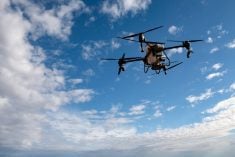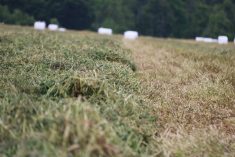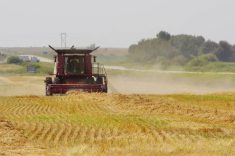[UPDATED: Oct. 11, 2023] An early harvest gives farmers the opportunity to get ahead of weeds for next season, says Manitoba Agriculture weed specialist Kim Brown.
Weeds have had ample time to grow after harvest, making them prime targets for herbicide.
Why it matters: As harvest winds down, attention turns to field preparation for 2024.
Read Also

Journal pulls long-cited glyphosate study for ethics violations
The journal Regulatory Toxicology and Pharmacology has retracted a 2000 Monsanto-linked glyphosate review, drawing new scrutiny as Bayer faces mounting legal pressure.
There are also fall-germinated weeds to contend with.
“We want to get after those weeds,” said Brown. “We have no idea what we’re looking at going into the winter when it comes to moisture. We do not want these weeds to use up valuable moisture.”
September onward is often pegged as a good time to tackle perennial weeds. Species such as thistles, dandelions and quack grass often top that list.
Pre-harvest applications will have helped, the weed specialist noted, but producers can’t always get a good spray application and even if they do, weeds may crop up again at the end of the season.
“There is lots of kochia in lots of fields,” Brown said. “It’s just getting worse and worse. It’s probably our number one weed across the province.”
The weed germinates early and farmers may face a serious kochia problem next season, given the number of good-sized plants still standing in fields.
Winter annuals
Winter annuals are another weed category to tackle. These include narrow-leaved hawksbeard, night-flowering catchfly, white cockle, stinkweed and cleavers.
“A winter annual germinates in the fall, goes dormant over the winter, and then pops up first thing in the spring and is able to start growing before anything else does, so it’s robbing nutrients and moisture,” Brown said.
“They’re really hard to get with an in-crop spray because usually, by the time we get around to doing those in-crop sprays, they’re far too large to control.”
Summer annuals
As for summer annuals, “I’m concerned about our pigweeds because we are seeing more resistance,” added Brown. “Even just our red root pigweed — a lot of that is Group 2 resistant now, and we don’t want those setting seed at all.”
All pigweeds can germinate early in spring but they also germinate late in the fall and can set seeds.
“We don’t want that happening, especially when we’re talking about waterhemp,” she said.

This weed, now being found across the province, is resistant to glyphosate, as well as Groups 2, 5 and 14 chemistries.
“Those are the only tests we’re doing, so we don’t know what else they’re resistant to, but we do know they are coming in with resistance already,” Brown warned.
As a Schedule 1 weed under the Noxious Weeds Act, waterhemp requires diligence to control.
“Where those weeds have been cut off, they’ll regrow from below where they were cut, and they will still set seed, so that’s something that we’re really concerned about,” said Brown.
Other weeds
Wild oats and lamb’s quarters also continue to present problems.
“If we’ve got regrowth, we always seem to have lots of lamb’s quarters around harvest time,” she said. “Whether or not we can get those weeds with a fall pass just depends on how much regrowth we can get from them.”
Ideally, farmers should allow four to six weeks of regrowth before spraying.
“That’s a long time, so that doesn’t always happen. But basically, you need to have green, growing tissue. Four leaves minimum, or maybe six for some of our perennial weeds.”
While spraying for perennials should be underway, Brown said farmers can wait a little longer for winter annuals to ensure they’ve fully emerged.
“We still haven’t had a really hard killing frost across the province. We’ve had little bits of frost here and there, but it hasn’t been that bad yet.”
Based on recent forecasts, Manitoba could reach mid-October before getting a killing frost.
“That gives us a lot of time, but you need to make sure you get that weed control done,” said Brown. “You want to put those products on before we get that killing frost.”
When spraying for weeds, temperatures must be above 8 C for a few hours after application. Brown suggested mid-morning or early afternoon passes to meet that threshold.
In regions with light frost, farmers will have to assess whether there’s enough growth to make spraying worthwhile.
“You need to have about 60 per cent of the leaf tissue alive, so we can spray quite late in the fall,” said Brown. “Even after some light frost, we can still spray, but you need to have living plants to be able to take up those products.”
She suggested waiting two to three days after a frost to assess the smaller weeds.
“If they’re very wet-looking and black-looking within a day or two, you know that they’re not worth spraying anymore.”
More time will be needed to assess bigger weeds.
Growers who plan to pull iron this fall will also have to be patient. Brown suggested waiting at least three days (and longer if possible) after spraying any product that needs to reach the roots. This gives the product time to get where it needs to go.
Most products are either recommended or must be sprayed with glyphosate, and Brown said it’s important to keep an eye on rate.
“Low rates don’t cut it if there’s very little leaf material, so depending on the weeds and depending on how much leaf material there is, you may need to bump those fall rates up.”
Scouting is always recommended, particularly as more herbicide resistant weeds appear.
“We need to make sure we set those fields up for success the following spring,” said Brown. “That’s the big message. We can’t forget about weed control once the combines are done.”
*Update: Kochia was mistakenly listed as a perennial weed. We apologize for any confusion this may have caused.















